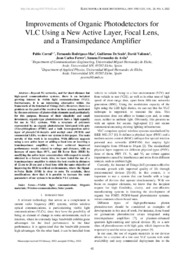Título :
Improvements of Organic Photodetectors for VLC Using a New Active Layer, Focal Lens, and a Transimpedance Amplifier |
Autor :
Corral González, Pablo
Rodríguez-Mas, Fernando 
De Scals Martin, GUILLERMO 
Valiente, David 
Ferrer, Juan Carlos 
Fernandez de Avila, Susana  |
Editor :
Kaunas University of Technology |
Departamento:
Departamentos de la UMH::Ingeniería de Comunicaciones |
Fecha de publicación:
2022 |
URI :
https://hdl.handle.net/11000/35425 |
Resumen :
Beyond 5G networks, and for short distance but high-speed communication systems, there is an incipient growing interest in visible light communications (VLC). Furthermore, it is an interesting alternative within the framework of the Internet of Things (IoT). However, there is a problem on the part of the receiver in these systems, motivated by the non-existence of photovoltaic elements used particularly for this purpose. Because of their simplicity and small investment, organic-type photodetectors have a high capacity for use in VLC systems. With a structure of polymers represented by an organic photodetector fabricated with poly (3-hexylthiophene) (P3HT) and a bulk heterojunction active layer of phenyl-C61-butyric acid methyl ester (PCBM) and commercial LEDs, we show our system in this paper. The main novelty of this work is in reception. With different upgrade using a new active layer or adding a focal lens or inserting a transimpedance amplifier, we have achieved improved performance results related to voltage and distance, with an increase of more than 40 %, and Bit Error Rate (BER) by modifying the active layer concentration with respect to results obtained in a former work. Also, we have tested the use of a transimpedance amplifier to obtain the best results in distances of 12 cm to 20 cm and a focal lens with the same objective of improving the BER in critical environments, where the Signal-to-Noise Ratio (SNR) is close to zero. To conclude, these modifications show that it is possible to increase the main parameters of our system to be useful in VLC systems.
|
Palabras clave/Materias:
visible light communication
organic materials
wireless communication
solar panels |
Área de conocimiento :
CDU: Ciencias aplicadas: Ingeniería. Tecnología |
Tipo de documento :
info:eu-repo/semantics/article |
Derechos de acceso:
info:eu-repo/semantics/openAccess
Attribution-NonCommercial-NoDerivatives 4.0 Internacional |
DOI :
https://doi.org/10.5755/j02.eie.31292 |
Publicado en:
ELEKTRONIKA IR ELEKTROTECHNIKA |
Aparece en las colecciones:
Artículos Ingeniería Comunicaciones
|
 La licencia se describe como: Atribución-NonComercial-NoDerivada 4.0 Internacional.
La licencia se describe como: Atribución-NonComercial-NoDerivada 4.0 Internacional.
.png)
